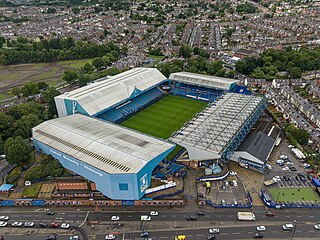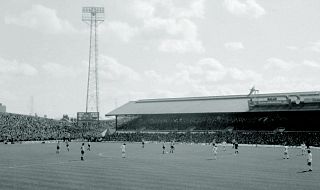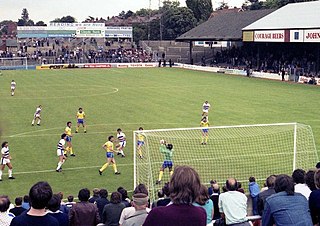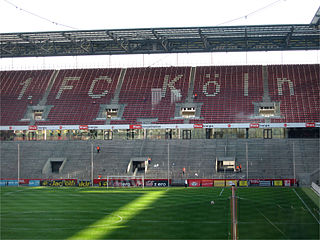Findings
Taylor concluded that "policing on 15 April broke down" and "although there were other causes, the main reason for the disaster was the failure of police control." [8] Attention was focused on the decision to open the secondary gates; moreover, the kick-off should have been delayed, as had been done at other venues and matches.
Sheffield Wednesday were criticised for the inadequate number of turnstiles at the Leppings Lane end and the poor quality of the crush barriers on the terraces, "respects in which failure by the Club contributed to this disaster." [9]
Police control
Taylor found there was "no provision" for controlling the entry of spectators into the turnstile area. Questioned why more action had not been taken to screen individuals and improve the flow of supporters approaching the stadium from the west "where the turnstile area was so small and awkwardly laid out", senior police officers responded that policy and practice had been no different from in the past, and they had no reason to anticipate problems as earlier events had proceeded without major incident. In fact, Taylor noted only two occasions when the entry at Leppings Lane had been the sole access to the north and west sides of the ground, at the 1987 and 1988 semi-finals, with evidence of congestion at both, but owing to good fortune and circumstance police policy "was not put to the same test and strain as a year later".
The senior police officers said it had never happened before so there was no reason to foresee it. In fact, the only two previous occasions when the Leppings Lane terraces had been used to fill the whole of the north and west sides of the ground were at the two semi-finals, in 1987 and 1988. In 1987, the match was on a Sunday scheduled for 12 noon, and kick-off was postponed for a quarter of an hour because of late arrivals. [10]
The need to open gate C was due to dangerous congestion at the turnstiles. That occurred because, as both Club and police should have realised, the turnstile area could not easily cope with the large numbers demanded of it unless they arrived steadily over a lengthy period. The Operational Order and police tactics on the day failed to provide for controlling a concentrated arrival of large numbers should that occur in a short period. That it might so occur was foreseeable and it did. [11]
As a result of the inadequate number of turnstiles, it has been calculated that it would have taken until 3:40 pm to get all ticket holders into the Leppings Lane end had an exit gate not been opened. Gate C was opened to let fans in, but the number of fans entering the terrace was not thought to have been more than the capacity of the entire standing area. Once inside the stadium, most fans entering the terraces headed for the central pens 3 and 4, as directed by a large sign above the access tunnel.
Since pens 3 and 4 were full by 2.50 pm, the tunnel should have been closed off whether gate C was to be opened or not. ... [I]t should have been clear in the control room where there was a view of the pens and of the crowd at the turnstiles that the tunnel had to be closed. If orders had been given to that effect when gate C was opened, the fans could have been directed to the empty areas of the wings and this disaster could still have been avoided. Failure to give that order was a blunder of the first magnitude. [12]
Standard procedure for league fixtures was to estimate the size of the visiting fan base, determine how many enclosures need to be opened, then fill each standing area one at a time. [13] For all-ticket games that had sold out, such as semi-final matches, a different approach was adopted whereby supporters were allowed to enter any enclosure they wished upon arrival. There was no mechanical or electronic means for calculating when individual enclosures had reached capacity. A police officer made a visual assessment before guiding fans to other pens. [14]
Whilst in theory the police would intervene if a pen became "full", in practice they permitted the test of fullness to be what the fans would tolerate. By 2.52 pm when gate C was opened, pens 3 and 4 were over-full even by this test. Many were uncomfortable. To allow any more into those pens was likely to cause injuries; to allow in a large stream was courting disaster. [15]
The official combined capacity of the central pens was 2,200, but the Health and Safety Executive found this should have been reduced to 1,693 as crush barriers and perimeter gates did not conform to the Green Guide. [16] It is estimated that more than 3,000 people were in the pens shortly after kick off at 3:00 pm. Overcrowding caused the fatal crush.
When spectators first appeared on the track, the immediate assumption in the control room was that a pitch invasion was threatened. This was unlikely at the beginning of a match. It became still less likely when those on the track made no move towards the pitch. ... [T]here was no effective leadership either from control or on the pitch to harness and organise rescue efforts. No orders were given for officers to enter the tunnel and relieve pressure. [17]
The anxiety to protect the sanctity of the pitch has caused insufficient attention to be paid to the risk of a crush due to overcrowding. Certain it was, that once the crush occurred on 15 April gates 3 and 4 were wholly inadequate for rescue purposes. [18]
Lord Taylor regarded spectator allocation irrelevant to the disaster. "I do not consider choice of ends was causative of the disaster. Had it been reversed, the disaster could well have occurred in a similar manner but to Nottingham supporters." [8]
Aggravating factors
There were accusations that the behaviour of Liverpool fans contributed to the disaster; these accusations centred around consumption of alcohol before the game and attempts to enter the ground without a ticket. Although Lord Taylor acknowledged that these factors aggravated the situation, he concluded that they were secondary issues. Witness estimates of the number of drunken fans varied from a minority to a large proportion of the crowd. Although it was clear many fans had been drinking, Lord Taylor unequivocally stated that most of them were: "not drunk, nor even the worse for drink." He concluded that they formed an exacerbating factor [19] and that police, seeking to rationalise their loss of control, overestimated the element of drunkenness in the crowd. [20]
The Hillsborough Independent Panel later noted that, despite being dismissed by the Taylor Report, the idea that alcohol contributed to the disaster proved remarkably durable. Documents later disclosed confirm that repeated attempts were made to find supporting evidence for alcohol being a factor and that available evidence was significantly misinterpreted. It noted, "The weight placed on alcohol in the face of objective evidence of a pattern of consumption modest for a leisure event was inappropriate. It has since fuelled persistent and unsustainable assertions about drunken fan behaviour." [21]
The possibility of fans attempting to gain entry without tickets or with forged tickets was suggested as a contributing factor. South Yorkshire Police suggested the late arrival of fans amounted to a conspiracy to gain entry without tickets. However, analysis of the electronic monitoring system, Health and Safety Executive analysis, and eyewitness accounts showed that the total number of people who entered the Leppings Lane end was below the official capacity of the stand. Eyewitness reports suggested that tickets were available on the day, and tickets for the Leppings Lane end were on sale from Anfield until the day before. The report dismissed the theory. [10]
Police evasion
Taylor concluded his criticism of South Yorkshire Police by describing senior officers in command as "defensive and evasive witnesses" who refused to accept any responsibility for error.
In all some 65 police officers gave oral evidence at the Inquiry. Sadly I must report that for the most part the quality of their evidence was in inverse proportion to their rank. [8]
It is a matter of regret that at the hearing, and in their submissions, the South Yorkshire Police were not prepared to concede they were in any respect at fault in what occurred. ... [T]he police case was to blame the fans for being late and drunk, and to blame the Club for failing to monitor the pens. ... Such an unrealistic approach gives cause for anxiety as to whether lessons have been learnt. It would have been more seemly and encouraging for the future if responsibility had been faced. [22]
Effect on stadiums in Britain

The Taylor Report had a deep impact on safety standards for stadiums in the UK. Perimeter and lateral fencing was removed, and many top stadiums were converted to all-seated [23] purpose-built stadiums for Premier League, and most Football League teams since the report are all-seater. [24] Chester City F.C.'s Deva Stadium was the first English football stadium to fulfil the safety recommendations of the Taylor Report, with Millwall F.C.'s The Den being the first new stadium to be built that fulfilled the recommendations.
Lord Taylor noted that the evidence he received was overwhelmingly in favour of more seating accommodation, and that most was in favour of reversing the two-thirds to one-third standing-seating ratio. [25] His final report made 76 recommendations, [26] including a reduction in standing in line with this evidence but that, after a given timescale, all stadiums designated under the Safety of Sports Ground Act 1975 should admit spectators to seated accommodation only. [27] A number of his recommendations were not implemented, including all-seating for sports other than football. [28] The Football Spectators Act 1989 contained a regulation requiring football grounds to become all-seated as directed by the Secretary of State. [29] This was to be overseen by the Football Licensing Authority [30] (now the Sports Grounds Safety Authority).
In July 1992, the government announced a relaxation of the regulation for the lower two English leagues (known now as League One and League Two). The Football Spectators Act does not cover Scotland, but the Scottish Premier League chose to make all-seater stadiums a requirement of league membership. [31] However, the regulations were applied to Berwick Rangers, a team located in England and playing in Scotland's national leagues. [32] In England and Wales, all-seating is a requirement of the Premier League [33] and of the Football League for clubs who have been present in the Championship for more than three seasons. [34]
Several campaigns have been active in attempting to get the government to relax the regulation, and allow standing areas to return to Premiership and Championship grounds. [35]

















